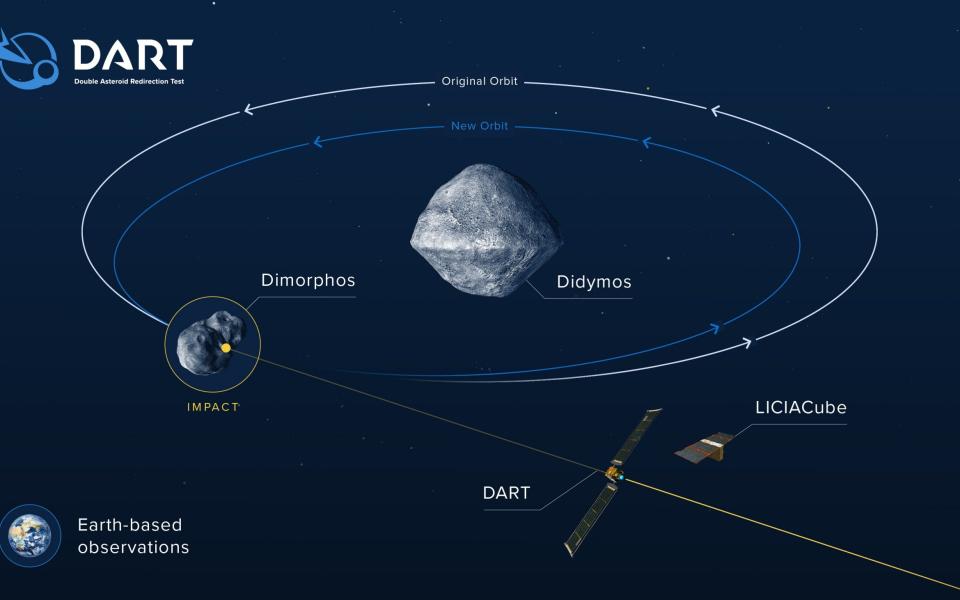Nasa ready to crash £300m spacecraft into an asteroid

Nasa will on Monday night deliberately smash a £300 million spacecraft into an asteroid in a first-of-its-kind experiment to try and alter the course of a space rock.
In the movies Armageddon and Deep Impact, astronauts save the world by flying to an asteroid and a comet, respectively, and blowing them up with nuclear bombs, thus saving the world.
But, in real life, if a meteorite is set to hit Earth and destroy life as we know it then the solution is likely to be better planned and less dramatic. Nasa’s Dart mission is the first iteration of this planetary defence mechanism.
Dart stands for Double Asteroid Redirection Test and is a 1,100lb cube that will crash into Dimorphos – a 525ft-wide “moonlet” orbiting the larger asteroid Didymos — at 00:14am Tuesday morning.
The asteroid is almost seven million miles away and poses no threat to our planet but is being used as a trial run to see if human technology has the ability to move asteroids away from a collision course with Earth.
Dimorphos is a well-studied space rock, with its size, dimensions and speed all known, and scientists will track how the 11,000mph Dart collision alters the moonlet’s trajectory.
Currently, it travels around Didymos once approximately every 11 hours 55 minutes and astronomers hope that they will be able to observe a small alteration to this as a result of the spacecraft — which is the same size as an industrial-sized washing machine and weighs 1,100lbs (500kg) — smashing into its surface.

They will do this by timing how long Dimorphos takes to orbit Didymos and seeing if Dart has had any effect while cubesats, released from Dart before impact, will capture images.
Disruption caused by Dart is not expected to be vast but should be enough to have a significant impact over time.
Tom Statler, a programme scientist at Nasa, said earlier this month: “It’s the equivalent of damaging your wristwatch. You might not notice it on the first day, but after a while you would begin to notice that it’s not keeping the time any more and that’s what we’re going to be watching for.
“If something the size of Dimorphos were to hit Earth, it could be regionally devastating and could have carry-on effects that would affect everyone on the planet.
“Asteroid impacts are a natural hazard that has been an issue for Earth its entire history, but it’s a natural hazard that can be made preventable.”
The twin-asteroid system, which was discovered in 1966, orbits the Sun every 771 days and is classed as potentially hazardous to Earth.
The asteroids will be around 6.8 million miles from Earth when the collision happens, and it has taken 10 months for the Dart spacecraft to reach the system after launching in November 2021.
It is humankind’s first planetary defence test and has involved input from more than 27 countries. The asteroids have never been seen up close, and once Dart nears the system it will switch on an autonomous navigation process to make the final journey.
‘Rewriting a page of space history’
In 2026, the European Space Agency (Esa) will also send its Hera spacecraft to the asteroid system to study the crater shape and model the interior structure.
Once the mass and size of the asteroid is known, the team will be able to determine what kind of impact is needed to move other asteroids that may be a threat to Earth.
Ian Carnelli, Hera mission manager at the Esa, said: “We are rewriting a page of space history in the coming days, so this is really an exciting time for all the space agencies involved.
“This is the first time humankind is going to be able to divert an asteroid so that we can safety protect our planet.”
Asteroids are left-over matter from the formation of planets and range in size from a few feet to tens of miles.
Just like Earth, they orbit the Sun and sometimes come dangerously close to Earth, yet currently there is nothing that can be done to deflect an incoming threat.
There are tens of millions of asteroids larger than 30ft that would have more energy than a small nuclear weapon if they entered the Earth’s atmosphere. So far, scientists have identified 21,443, fewer than 20 per cent of the total.
Nancy Chabot, Dart coordination lead at Johns Hopkins APL, said: “This asteroid is not a threat to Earth. There are no known asteroids that are a threat for the foreseeable future but we want to develop the technology to be ready for when we potentially need it.”

 Yahoo Movies
Yahoo Movies 
